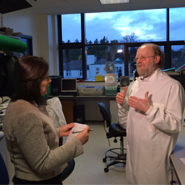Cystic Fibrosis discovery may lead to new treatment strategy to help patients breathe easier

An international team of scientists led by UC San Francisco (UCSF), Professor of Medicine John Fahy, MD, and involving scientists from University College Dublin has discovered why mucus in the lungs of people with cystic fibrosis (CF) is thick, sticky and difficult to cough up; leaving these patients more vulnerable to lung infection. The work was reported in Science Translational Medicine.
The research, a collaborative effort between UCSF, University College Dublin (Professor Stefan Oscarson and Professor Stephen D. Carrington) and the Cleveland Clinic, in Ohio, has implications for other lung conditions characterised by thickened mucus, such as chronic obstructive pulmonary disorder (COPD) and asthma.
Pictured far right: UCD’s Prof Stephen Carrington tells RTE TV News’ Helen Donohue how the scientific discovery may lead to treatment to help Cystic Fibrosis patients breath easier
Prof Fahy and his team found that in CF – contrary to previous belief – inflammation causes new molecular bonds to form within mucus, transforming it from a liquid to an elastic sludge. The scientists also made headway in the lab in exploring a potential new therapeutic approach to dissolve those bonds and return the mucus to a liquid that is easier for the lungs to clear.
Cystic fibrosis is a lifelong inherited disease that affects the lungs and digestive system. There is no cure. About 30,000 children and adults in the United States have CF. Ireland has the highest incidence of Cystic Fibrosis in the world – approximately 1 in 19 Irish people are said to ‘carry’ one copy of the altered gene that causes Cystic Fibrosis.
Polymers – naturally-occurring molecules in mucus that form long chains – are the key to the discovery. Until now, scientists had thought that CF mucus is thicker than healthy mucus because it has a greater concentration of DNA polymers. To test that idea, Fahy and his group exposed mucus samples taken from CF patients to two current CF medications: Pulmozyme, a drug that breaks up DNA polymers, and N-acetylcysteine (NAC), which targets disulfide bonds between mucin polymers. Mucin is a protein that is the major constituent of mucus.
“We thought Pulmozyme would be more effective than NAC in liquefying the mucus, because CF sputum contains lots of DNA,” said Prof Fahy. “But to our surprise, NAC worked much better.”
Using confocal microscopy, the scientists learned why: CF mucus consists of a dense core of mucin with a layer of DNA wrapped around it, like a thin blanket draped over a solid pillow. Thus, while Pulmozyme makes mucus less stiff by eliminating DNA, NAC succeeds in liquefying it by breaking up the mucin.
Prof Fahy and his team then investigated why mucin in CF is so compacted. They found that mucin polymers become linked together crosswise by newly-forged disulfide bonds. Fahy likened the polymers to logs floating down a river. “The logs can float down the river as long as they are floating independently,” he said. “But if you bolt them together side to side, they will clog the river.”
The researchers found that inflammation causes the extra disulfide bonds to form, when mucin polymers are exposed to highly reactive oxygen molecules released by inflammatory cells in a process called oxidative stress.
This observation was confirmed by a device invented by lead investigator Leo Shaopeng Yuan, of the UCSF Cardiovascular Institute. In separate chambers, mucus from healthy volunteers was exposed to pure oxygen and pure nitrogen. The mucus exposed to oxygen became thick and elastic within seconds. The mucus exposed to nitrogen remained liquid.
“This qualitative change, driven by oxidation, happens with other natural polymers,” said Prof Fahy. “Think of latex, which starts out as liquid tree sap. When it’s vulcanized – a process of chemical cross-linking – it turns into the solid rubber we use in tires.”
Prof Fahy noted that patients who are treated with pure oxygen in hospital intensive care units have long been known to develop sticky mucus. “This could be a function of the oxygen that’s used to treat them,” he said.
Finally, the research team turned its attention to the possibility of creating new treatments for CF that would target disulfide bonds in mucin polymers directly and efficiently.
NAC, which targets mucin polymer bonds, is already an approved medication used to break up mucus. “However,” said Fahy, “there are problems with it. It’s a relatively weak drug, and it smells like rotten eggs.”
Team member Professor Stefan Oscarson, a medicinal chemist from University College Dublin, designed TDG, an experimental compound that targets disulfide bonds. TDG liquefied mucus samples from CF patients much more efficiently than NAC.
Prof Fahy cautioned that TDG cannot yet be given to human beings. He noted that while the team has applied for funding to develop their promising new therapeutic approach, “there are at least five years of testing ahead before we can say we have a new medication.”
He predicted that the new finding will explain the reason for thick mucus in other lung diseases known to be associated with oxidative stress, including COPD and asthma. “We’re very confident that we’ve uncovered a ubiquitous mechanism here,” he said.
The study was supported by funds from the National Institutes of Health and Genentech.
The scientific paper is entitled Oxidation increases mucin polymer cross-links to stiffen airway mucus gels (Sci. Transl. Med. 7, 276ra27 (2015)) by Shaopeng Yuan, Martin Hollinger, Marrah E. Lachowicz-Scroggins, Sheena C. Kerr, Eleanor M. Duncan, Brian M. Daniel, Sudakshina Ghosh, Serpel C. Erzurum, Belinda Willard, Stanley L. Hazen, Xiaozhu Huang, Stephen D. Carrington, Stefan Oscarson and John V. Fahy.
Sci. Transl. Med. DOI: 10.1126/scitranslmed.3010525
Cystic Fibrosis is a genetically inherited disease that primarily affects the lungs and the digestive system. Ireland has the highest incidence of Cystic Fibrosis in the world – approximately 1 in 19 Irish people are said to ‘carry’ one copy of the altered gene that causes Cystic Fibrosis. For information visit www.cfireland.ie